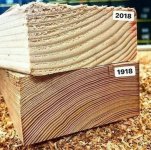When it comes to shaft wood, Viking always did it right. Unless they recently changed their process, it takes 3 years to make a shaft. Start with a large blank. Turn it. Store it in humidity controlled environment for a period of time. Repeat process several times until a finished shaft is produced. I dont recall anyone complaining that their Viking shaft has warped when using common sense storage techniques.
They (and other cue makers) choose Northern Hard Rock Maple. Why? Because in the northern States and Canada, it takes the tree longer to grow. The grow rings are tighter, and makes a denser, more stable wood.
As an example, Stradivarious violins are claimed to be superior because of the dense wood used.
From Wikipedia...
"A more modern theory attributes tree growth during a time of global low temperatures during the Little Ice Age associated with unusually low solar activity of the Maunder Minimum, circa 1645 to 1750, during which cooler temperatures throughout Europe are believed to have caused stunted and slowed tree growth, resulting in unusually dense wood.[50][1] Further evidence for this "Little Ice Age theory" comes from a simple examination of the dense growth rings in the wood used in Stradivari's instruments.[51] Two researchers – University of Tennessee tree-ring scientist Henri Grissino-Mayer and Lloyd Burckle, a Columbia University climatologist – published their conclusions supporting the theory on increased wood density in the journal Dendrochronologia.[52]
In 2008, researchers from the Leiden University Medical Center in the Netherlands, announced further evidence that wood density caused the claimed high quality of these instruments. After examining the violins with X-rays, the researchers found that these violins all have extremely consistent density, with relatively low variation in the apparent growth patterns of the trees that produced this wood.[12]
Yet another possible explanation is that the wood was sourced from the forests of northern Croatia.[53] This maple wood is known for its extreme density resulting from the slow growth caused by harsh Croatian winters. Croatian wood was traded by Venetian merchants of the era, and is still used today by local luthiers and craftsfolk for musical instruments."
